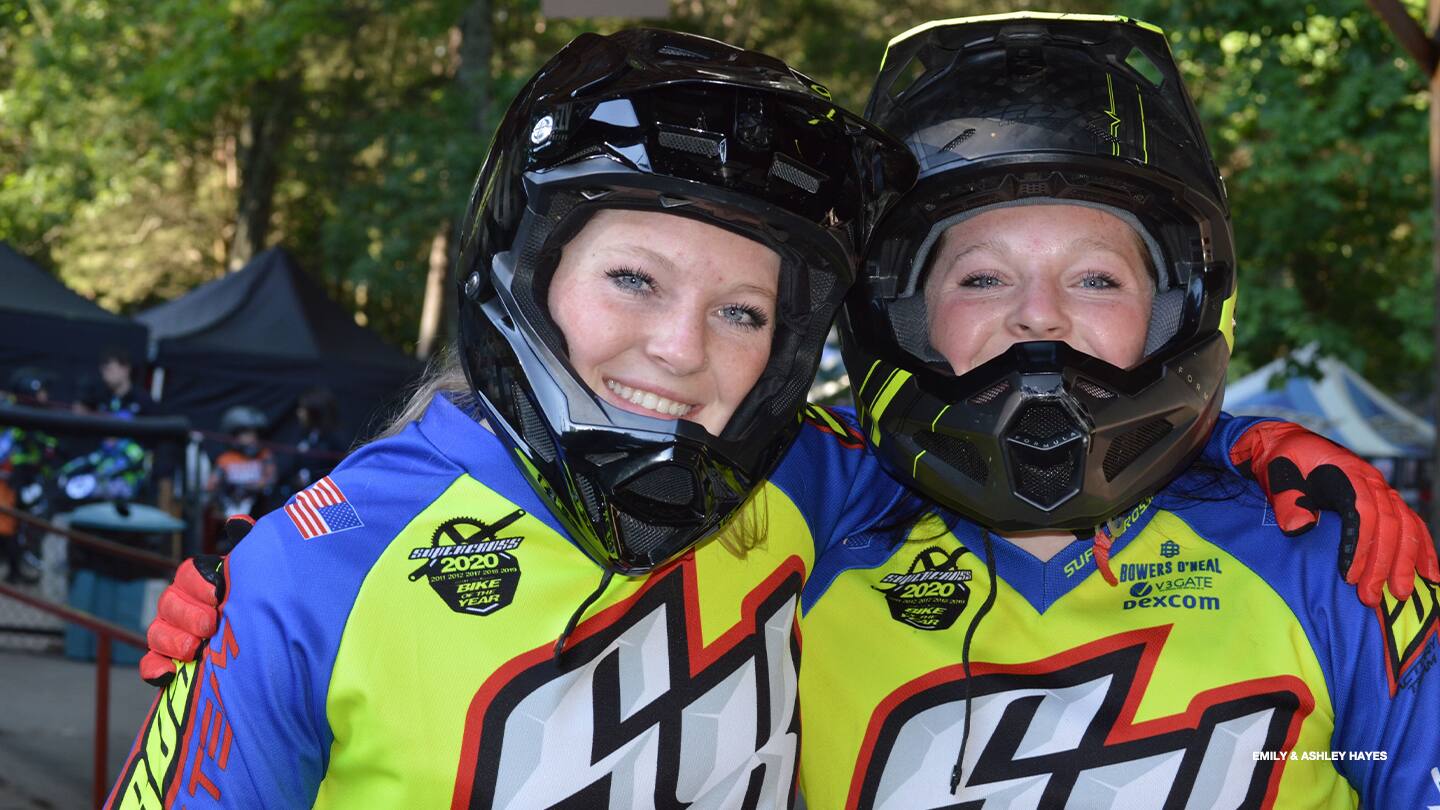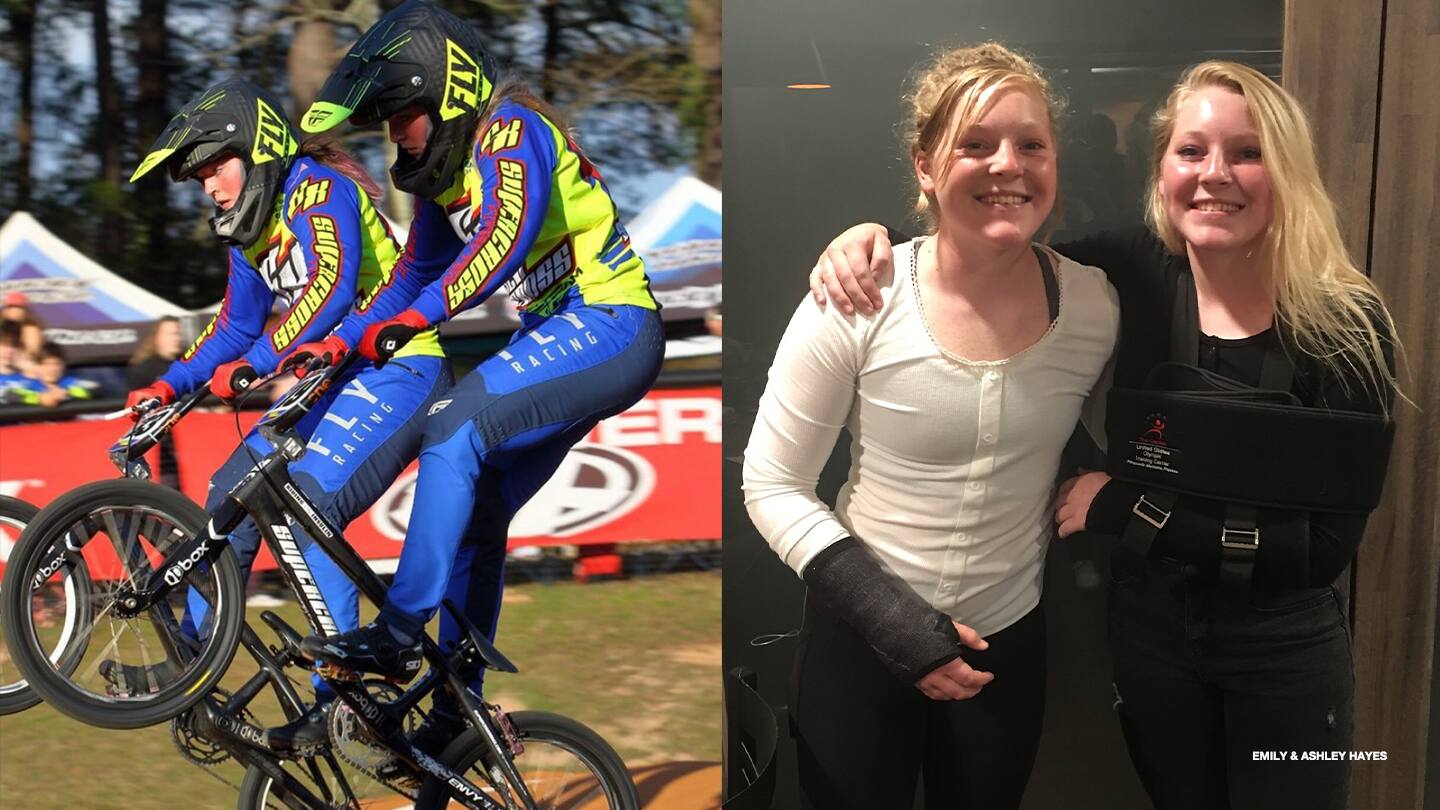BMX’s Ashley And Emily Hayes Reveal How They Recover After Injury
by Lisa Costantini

Sisters Ashley and Emily Hayes are both BMX athletes hoping to make the 2020 U.S. Olympic Team.
For 19-year-old BMX racers Ashley and Emily Hayes, when they do something, they almost always do it together. The twin sisters, or “wombmates and best friends” as they call themselves, started their sport at the same age — at 9.
“Ashley started two weeks earlier than me because my bike took a long time to ship,” Emily remembered about that Wal-Mart bike.
Ashley has been leading the way ever since. She was also the first one to be diagnosed with Type 1 diabetes, at age 3. Over the years, she has got good at juggling her diagnosis with her racing. But she said she has to pay close attention to any issues she might be having so that her body is always healthy and race-ready.
For Emily, her diagnosis came a year later, and was exciting because it was another way she got to be like her sister — the person who inspires her the most.
“She just works really hard,” Emily said. “Her mentality going into racing and on the track… She inspires me to have that kind of mentality.”
The feelings are mutual, Ashley said. “Emily inspires me to do better, to perform better and to handle situations better.”
The Colorado Springs, CO natives — who both hope to make the Olympic team in 2024 — seem to get injured around the same time, too.
In 2019 when Emily crashed and dislocated her shoulder at a world championship, the most painful part of her recovery was that her twin wasn’t doing physical therapy with her.
Thankfully Emily said her sister “came to P.T. with me — for support.”
Family has always been a big part of their sport as they grew up riding BMX on the track their parents ran in Colorado Springs. It was there where they first started racing with the entire family — mom, dad and their three older siblings included.
In physical therapy it wasn’t long before Ashley was there for herself. “I was skiing and tore my ACL,” she revealed about the worst injury she has ever experienced — and it wasn’t a result of BMX. “I had to get a complete ACL replacement.”

Ashley has also broken her wrist twice and torn ligaments. Not a surprise since “put me on anything that goes fast and I go fast,” she said.
No stranger to the E.R. either is Emily, having had two broken elbows, broken wrists and a broken hand in addition to her shoulder surgery.
With her shoulder surgery, she was unable to ride for six months — and out of competitions for three times that long. “It was quite a while,” she remembered. “And it was around a year before I was comfortable riding again where I wasn’t scared,” Emily said.
For Ashley, she tends to think of her time recovering off the bike the same way she does about her time on the bike: “Trying to get through recovery as an athlete I’ve learned that you’ve got to have a lot of patience and just as much determination as you do when you’re training. If you are training to win a race, you are going to put in the time and effort. Same thing if you want to recover and heal. You just have to shift your mindset, and change your goals,” she explained.
With BMX racing being an individual sport, the twins consider themselves lucky to have the support of each other. Emily shared that it would be rare to race without the other one next to her on the starting line. “We are always there to remind the other one that ‘you can do it. You just have to believe in yourself like I believe in you.’”
It was the same thing when they were both hurt and in physical therapy at the Colorado Center of Orthopaedic Excellence (C.C.O.E.), an Official U.S. Olympic and Paralympic Regional Medical Center.
“Recovery was really hard and painful, but we were there to remind each other that you can get through it,” Emily said.
Ashley credits the C.C.O.E. for helping both of them get back to the field of play. “Being injured isn’t fun, but I liked going to physical therapy,” she said knowing full well that “that sounds weird and kind of crazy.”
But it was because the therapists there “were doing everything they could to get you back and feeling good,” Emily said. “It was fun going in there because they made it such a fun environment.”
Though that doesn’t mean it was easy. Ashley thought back on the day she was cleared after her injury. “I was kind of scared,” she said. Because of that, she said she was too nervous to clip into her bike’s pedals and instead “rode flat shoes for a while.”
Emily related, and remembered a time after her injury when she was thinking, “there is no way I am going to ever get back to normal,” she said. But she got over the fear of getting hurt again. “The return to track feels awesome because you’re back to doing what you love, even though it felt like such a far-off thing when you got hurt.”
Her main piece of advice would be to give yourself grace. “There were a few times that I did not put down really good laps — and people that I know I could beat were beating me. I knew that I was still recovering and trying to get to that elite level again. I had to give myself some grace for what happened.”
Paying attention to those little successes also helped, Ashley said. “Like hey, the other day I ran on the treadmill for two minutes and now I’m doing three. You’re getting better every single day. Pay attention to the little improvements that you make and then all of a sudden, it’s like, I’m back!”
Lisa Costantini #
Lisa Costantini is a freelance writer based in Orlando. She has covered Olympic and Paralympic sports for various publications, and has contributed to TeamUSA.org since 2011.